




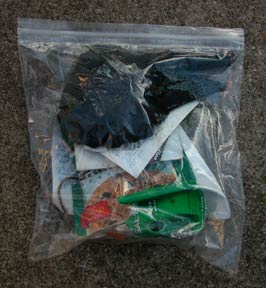
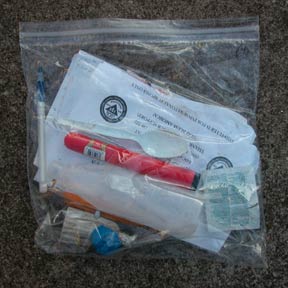
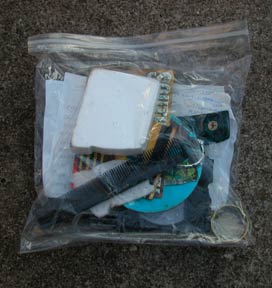
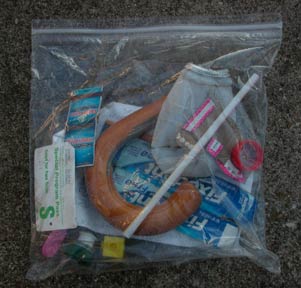
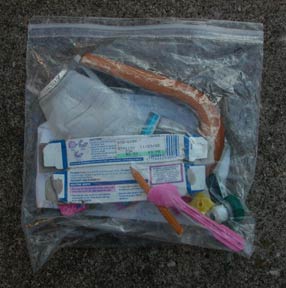

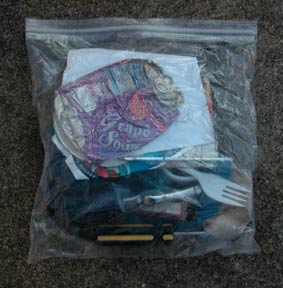
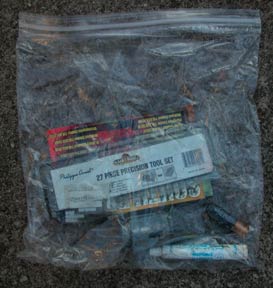

| The Bags
collected by the stuents. |
||||
 |
||||
|
One
of the most difficult aspects of the solid waste is that it is usually
not clean. If it is a container, usually there is residue of the material
left behind such as soda in a soft drink can. It can be sticky and stinky
with the growth of small cultures. In our case most of the rubbish had
been soaked by a freezing rainstorm the day before we picked it up, thus
by the time we got to the debris it was sealed in a thin frozen layer
of ice secured to the ground. By the time I got the rubbish to my studio
it had thawed and had begun to become damp and musty (pongy is a British
term even more appropriate). As soon as the box of rubbish arrived I opened
it up and spread it out in my studio and began carefully cleansing it
using a mild detergent wash, then placed it out to dry. I then began to
scan and digitally document each piece. Next, I will make a detailed inventory
of all the rubbish collected, noting the manufacturer, material, color,
shape, logos, addresses, and any other pertinent information. I reclaim what once had value now discarded, worthless, thrown “away” and unwanted in the streets. What does all this material signify and how does trash in London compare to the Bronx? Trash is global and free, an open source, which is a kind of consumer code that captures identity by that which is purchased and discarded. It signifies style, possibly a form of class and human behavior, and in some cases identities coded by what people purchase and throw away or lose. Trash is a free material for interrogation into modern culture – telling stories through consumer waste. |
|
|||
With the assistance of 10 students and their principal, Bill Elmore from Gateway Academy for Science, Mathematics and Research & JFK High School, the project began by students collecting solid waste on December 18, 2003, in two locations, southeast in Marble Hill and northeast Rosendale the Bronx. All the rubbish collected was approximately the size our hands: non-biodegradable, non-toxic materials that would fit into 12” X 10” plastic zip lock bags. We considered the process a form of sampling rather than attempting to pick up all the rubbish we found on the walk sites. We often invented narratives based on the fragments found in the streets & gutters, alleyways, and vacant lots. To pick up all that we encountered would have been impossible without more serious machinery and human power. The students were encouraged to pick up what they felt was most interesting to the place such as materials that had any markings specific to the Bronx, or of personal interest. Each piece of rubbish was listed on a 3 X 5” card notating the location that it was found then later further notation of color, material, manufacture, text/logos, addresses, potential function/purpose, and any other comments where collected onto a larger sheet of paper. The materials were then returned to the plastic bags along with the 3 X 5” cards and notes. The process is not much different than what an archaeologist might employ though we did not dig down into the earth for the materials. Rubbish was found conveniently on top the sidewalks, streets and alleyways-- discarded or lost. All the materials we collected in the Bronx were shipped to my studio in Baltimore where I have continued to process the materials. The materials will be cleaned, repackaged as artifacts or souvenirs of the Bronx with identifying documentation of where it was found. |
|
|||